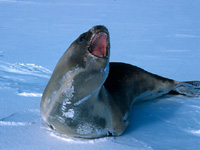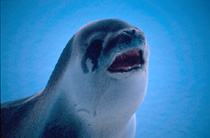Ross Seal
(Ommatophoca rossii)
IUCN STATUS (2010) - LEAST CONCERN
| Distribution and Numbers Named after the British explorer who obtained the first specimen, less is known about the Ross seal than any of the other Antarctic seals. The species is mostly found on the pack ice around the Antarctic continent, with a wide but dispersed circumpolar distribution. It is very difficult to determine how many of the species there actually are. The Ross seal is however the rarest of the four seal species breeding on the Antarctic pack ice, and one population estimate has been made of about 220,000. The greatest abundance of Ross seals appears to be in the Ross and King Haakon VII Seas. Wandering seals have been reported north of 60°S only on very rare occasions. |
 Photo: Michael Bryden, University of Sydney |
| Status Ross seals have been protected from large-scale commercial hunting due to their inaccessibility and the high cost of operating in the area. They are protected by the Antarctic Treaty and the Convention for the Conservation of Antarctic Seals (CCAS), although 30 were killed in 1986-1987 for commercial purposes under a special permit. In January 1998 the Environmental Protection Protocol to the Antarctic Treaty was ratified, implementing environmental measures such as the banning of mining and oil drilling in Antarctica for at least 50 years, along with the banning of refuse disposal and the use of pesticides in the region. The lesser importance of krill in the Ross seal diet should probably prevent the species from being badly affected by current pressures on krill stocks from the commercial fishery and from increased competition by other Antarctic marine mammals. |
 Photo: Erling S. Nord�y, University of Troms� |
Lifestyle Ross seals are the least studied of the Antarctic seals due to their dispersed and isolated distribution. They are usually observed as solitary individuals, appearing to prefer larger and more concentrated ice located further in from the ice pack edge than that preferred by leopard and crabeater seals. There is not much known> about the Ross seal's breeding season, but it probably takes place in November and December. The female nurses her pup alone for a short period, perhaps 2-3 weeks, and breeding may occur about one month after the pup is weaned. Pups are born with dark brown fur, lighter on the underside. Adult Ross seals have a dark grey to chestnut coat with a buff underside which they moult between January and February. Both pups and adults often have broad dark stripes between their chin and chest, and most adults have small pale scars around the neck and shoulders. |
| The Ross seal specialises in feeding on cephalopods, particularly squid. It is possibly this specialisation and the relative lack of cephalopods in the Antarctic pack ice for much of the year that has resulted in the species' scarcity. Fish and krill are also part of the seals' diet. The Ross seal is believed to be able to feed at depths of several hundred metres and its large eyes may aid its underwater vision. Killer whales prey on some Ross seals and there is possibly also some predation by leopard seals. Ross seals have a very distinctive "siren-like" call and when approached they often arch their backs and raise their heads near vertically in a recognisable posture. |
 Photo: Erling S. Nord�y, University of Troms� |
Statistics
Adult male Ross seals measure 1.7-2.1m in length and weigh 130-215kg, females generally larger at 2-2.4m and 160-200kg. Pups are born measuring 1.05-1.2m in length and weighing about 27kg. It is thought that females achieve sexual maturity at 3-4 years, males at 2-7 years.
